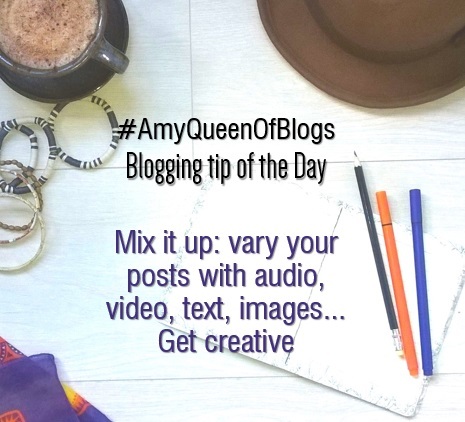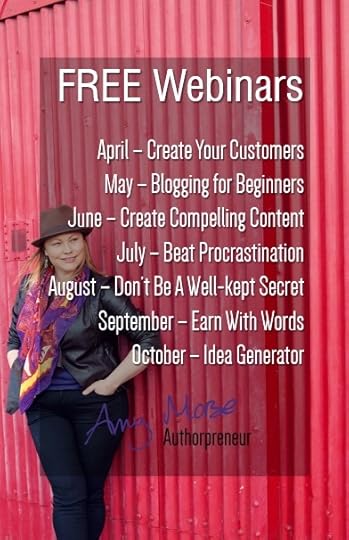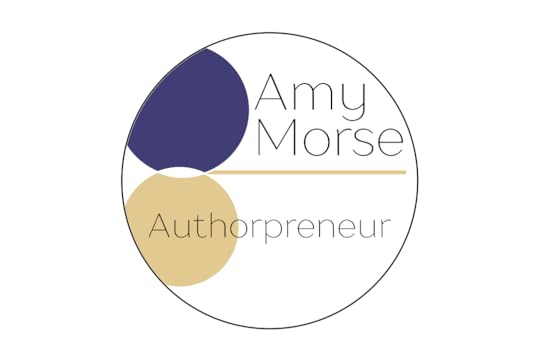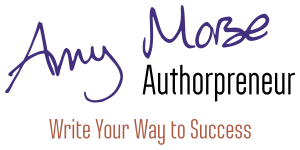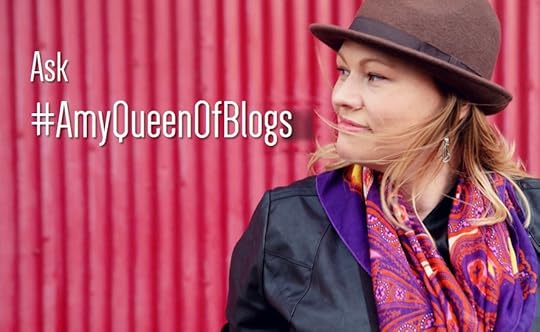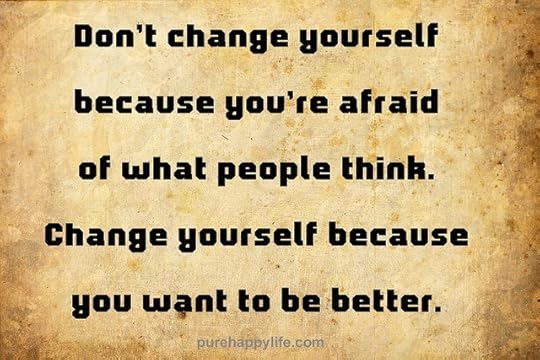Amy C. Fitzjohn's Blog, page 30
May 2, 2017
Event-Full Business Planning
Event hosting has been an integral part of my business since I launched in 2015.
It took me a while to realise that hosting and filling events on my own was a tall order!
Although I’ve moved away from putting on my own events – other than webinars – I still love collaborating with other businesses to put on an event, whether it’s running a skills workshop for their clients, or tailoring a workshop to help them unlock the hidden talent in their teams.
I’ve worked with Eventbrite – and even blogged for them – but up until last week, had never had my events on my website. Then I found ‘Time.ly’!
Behold… My Gorgeous New Calendar of Events.
I spent hours tapping in everything I’m involved in this year and was surprised to realise it numbered 20 events! (And counting…)
This quick piece of contributed content has some little gems to maximise your events:
Event-Full Business
Image courtesy of tricostar.com
It can be stressful investing time and money in running a business event, particularly if you can’t always count upon the outcome. An event such as a product exhibition or service workshop can help you to engage your customers face to face as well as help you to build brand awareness with new industries and customers. If you can get the right people to attend it is an excellent new business opportunity but that requires you to reach the right audience with your marketing strategy. If you have a business event coming up here are some top tips for getting it noticed.
Do your research
Before you begin to plan and advertise you will need to know who you want to attract, what part of your business they will be interested in and how to reach that audience. Once you know your audience profile you can build your event around it so that you get the right people through the door. If you want business leaders then you need to understand what time during the week they have to attend events, where would be central to their operations and what networks they use in order to publicise the event taking place.
Create a buzz
Once you have your event confirmed you will need to start publicising it. If you have done your homework you will know where your audience gets their information for example industry press, local media or through direct mail. You might want to choose one of these mediums or a mix to ensure you get a good attendance. Rule of thumb is that you need to invite four times the amount of people that you actually wish to attend if you want to secure the numbers. For media you should produce a press release that gives all the relevant details of the event and you might also want to invite media along to cover off the key points so that you can reach an even wider audience after the event. You will need to start publicising your event well in advance of the date so leave at least a month to let your audience get it into their diaries.
Go social
Creating a social media page and presence for your event is a great way of spreading the word. This works really well for events where there isn’t a specific attendee in mind. If you want a more private, closed and targeted event then ensure you publicise it as ‘by invitation only’.
Material details
Another important medium for publicising your event is printed marketing materials. These can be used as part of the direct mailing or to be put up/left in strategic business hubs. You can get all of your specialist printing needs catered for online by checking out companies such as Clone-media.
Smart Networks
Finally, don’t underestimate the importance of using your existing customer database and business networks to get people interested in your event. It is a free and self-selecting way of targeting like-minded people that are therefore more likely to want your product or service.
Book in for a FREE Webinar HERE
And check out my Calendar of Events for 2017
For monthly updates and special offers, sign up for my newsletter HERE.
Save
For instant updates when I publish a new blog post, Follow me on Bloglovin’
If you enjoy my blogs, buy me a coffee to say thanks.
Donate to my ‘Coffee Kitty’ here (£2.50 / $3 will get me a cappuccino). Thank you 
April 27, 2017
Blogging Or Vlogging: Which One Is Right For You?
It’s all about videos this week! Especially, vlogging.
A great guest blog on 5 Essential Tips to Become a Professional Vlogger and today, some contributed content.
Do you suffer from ‘screen fright’?
This is also very timely for me as I’ve been setting up mini film and recording studies in my office to create the content for the forthcoming launch of my online workshops.
Get involved by booking on for a FREE Webinar or sign up to my monthly ‘Inspiration in your inbox’ HERE.
Blogging Vs Vlogging
(Source: http://bit.ly/2plZoat )
If you spend some time on the internet, it won’t take long to see that vlogging is very popular. In fact, we even posted an article on it the other day. In this piece, we take a look at vlogging and compare it with its more word oriented brother, blogging. More to the point, which one would suit you best?
Are You Shy?
The great thing about blogging is that it allows you to be creative and show off your talents without having to show yourself to other people. You can write all of your posts at home, you’re protected by an invisible screen between you and your audience. This is perfect for anyone that’s a bit shy but loves creating content and voicing their opinion.
With vlogging, you get rid of that protective barrier and put yourself out there. You have to be incredibly confident to vlog, as it can involve you filming yourself in public with others watching you. Even just filming yourself in your room can feel awkward if you’re shy.
Unfortunately, shyness can inhibit your video content, which means vlogging is probably best for people that are more out there and self-confident.
Do You Like Editing?
Both bloggers and vloggers will spend some time editing their work. The difference is, a blogger has way less editing to do. Or, more specifically, the editing process isn’t as strenuous or difficult. For a blogger, you only have to read over your work, check its grammar, and make any adjustments. There are few things that can go wrong here.
But, for a vlogger, there are many things to consider and many things that can go wrong. You’ve got to use software to edit your videos, you have to import sounds and music then sync everything up. There could be issues with migrating and archiving video files, importing music and graphics, or even something as simple as an issue where the software crashes. Video editing can take hours, while written content editing takes half the time.
If you don’t like editing things, then I wouldn’t recommend vlogging!
Are You Creative?
Creativity is a must-have trait for both bloggers and vloggers. However, it’s something that’s not as essential for a blogger compared to a vlogger. You can create a blog about pretty much anything, it can literally be a site where you update people with the latest news on a certain topic. The content you produce doesn’t necessarily have to be that creative on a blog. Likewise, there isn’t a great deal you can do to be outrageously creative when you run a blog. Sure, you can definitely exercise your creativity, but it’s not the best way to do it.
With a vlog, you have a platform to be as creative as you dare. You have so many things to alter; the format of your videos, the way you edit, the content you produce, etc. Vlogging is certainly the most creative out of the two types.
If you love being in front of a camera, have an extremely creative mind full of different ideas, and love sitting down editing videos, then vlogging is perfect for you. If not, then blogging is probably the better choice.
For instant updates when I publish a new blog post, Follow me on Bloglovin’
If you enjoy my blogs, buy me a coffee to say thanks. Donate to my ‘Coffee Kitty’ here (£2.50 / $3 will get me a cappuccino). Thank you 
5 Essential Tips to Become a Professional Vlogger – A Guest Post
I’m hosting another guest on the blog this week. Vlogger, Martin Agger pitched this idea to me and I’m pleased to share his insights with you.
Although writing it my thing – I am an Author after all – great content needs to have variety, to keep your audience hooked, and to be friends with Google so more people can discover you.
Martin is an enthusiast photographer and YouTube addict. His Cinematiclab blog is packed with free access to guides and reviews on how to choose their Cinema & Photography gear, as well as different accessories and equipment.
Find out more about him here: http://cinematiclab.com/about/
And stay up to date with Martin on his Facebook page: https://www.facebook.com/CinematicLab/
5 Essential Tips to Become a Professional Vlogger
Vlogs are very similar to normal blogs where you communicate with your audience and share your thoughts about different subjects, but what’s most important both methods drive traffic to your business. However, whereas bloggers use the written word to communicate with their audience a vlogger will use a video. You can create a vlog on any topic that you like and many people will find it more entertaining than blogs. Becoming a vlogger is also a great way to establish your brand and let people know what you are thinking about. That way you can educate others and also get valuable experience for your personal development as well.
Actually, it is very easy to become a vlogger, all you need to do is create a video and put it on your YouTube channel. In a best-case scenario, your video might go viral and people from all over the world will have a chance to see it. So, to increase chances of making your video popular, you have to know what makes a good vlog. The following tips can help you become a successful video blogger and hopefully the famous YouTuber as well.
Vlog Whenever You Can
You are more likely to become a successful vlogger if you can post your vlogs on a regular basis. This will keep your audience interested and there is a higher chance they will subscribe to your channel. It also shows users that you have a lot of knowledge on the subject you are vlogging about and most importantly you are consistent on what you are doing.
The one thing that you do need to make sure is that you are not creating videos just because you have to. Your audience will want to see quality content and so if you are not sure that you have anything valuable to say, then it’s better to wait a while before posting your next vlog.
Make Sure You Have a High-Quality Video and Audio Equipment
The most important thing when vlogging is that your videos look and sound great. This will also make your channel look more professional. That being said whenever you are starting a new daily blog it is essential that you have a good quality equipment and it is worth paying an extra money to have the Best Vlogging Camera and equipment needed to start your very first YouTube channel.
There are several reasons why you should make an investment in good video and audio equipment when you are starting out as a vlogger. One of the main reasons is that it shows people that you are passionate about vlogging and that it’s something that you are going to make for next couple of years. This is important for beginner vloggers because people don’t watch videos from someone who is only going to upload one or two videos and the simply give up.
Consider Promotions and Advertising
It is not enough to just post your video and then hope that people stumble across it by themselves. You need to be actively promoting your vlog whenever you can. This does not have to be paid advertising, although you may consider this when you are starting to have some success. One of the most effective ways of promoting your vlog is to talk about it on social media and encourage your friends to watch and leave feedback.
In order to really get your video noticed you need to get a large number of views in the first 24 hours. Using social media before your video is uploaded gives you the opportunity to create excitement amongst your followers so it gets millions of views as soon as it is released.
Learn from Your Mistakes
There may be times that you make mistakes when you first start out as a vlogger. Even professionals can make mistakes from time to time. These mistakes can be embarrassing but as long as you learn from them, then there is not really much to worry about.
There is also a lot you can learn from other vloggers, especially if you watch videos from other YouTubers who talk about the same subjects as you. You do not want to copy them directly but it can give you some fresh ideas for topics that you want to cover. That way you channel will gradually grow and one day you might be better than your competitors.
Don’t Give Up
It may take some time for you to build up a large list of subscribers. You may not even get any views for your videos at first but the important thing is that you do not give up at this point. If you keep producing good quality videos and promote your vlog whenever you can, then you will start to see the number of viewers will increase.
Most vloggers do it for love, rather than for money but there is the potential to earn substantial amounts of money when you become popular. The thought of being able to earn a full-time income from something that you love should be an incentive for you to keep going, even if you do find things tough at the beginning.
Conclusion
Whether you are new to vlogging or you have been doing it for a while, these tips can help you become successful. Vlogging is a continuous learning curve but as long as you are producing videos with good content that are filmed with the best vlogging camera then you are increasing your chances of becoming a well respected vlogger in the YouTube community.
A big THANK YOU to Martin for contributing.
Join me on my mission to banish bad business writing and tell your story well in your own words.
I have a series of FREE webinars in 2017 to help your business and the way you communicate your messages evolve.
Save
The post 5 Essential Tips to Become a Professional Vlogger – A Guest Post appeared first on Amy Morse - Authorpreneur.
April 18, 2017
All Inclusive Web Design
This contributed content on inclusive web design is very timely for me.
As I build the next phase of my business online, my website will need a level up to host the online workshops I’m developing.
Initially, I’ll be hosting them on Teachable, but watch this space for updates, or book in for a webinar to find out how to create better content to add value to your business.
We often overlook inclusivity when designing our website, check out the link at the end to test your website.
All Inclusive Web Design
Your website is one of your most valuable assets whether you’re a multinational business or a sole trader. When designing your website then your focus will no doubt be on what it looks like and ensuring a constant stream of regular and relevant content. These are both important but an area often overlooked is how accessible your website is. Not just in terms of its navigation and signposting but whether it meets the individual and inclusive needs of your visitors.
There are guidelines and standards in place that a specialist website development agency will be very familiar with and will form part of their professional vocabulary. For the rest of us understanding web accessibility might seem like a daunting task. Here are some top tips for making your website more accessible.
Image sourced from Monsido
Keep it simple
Good content should be easy to understand whether you’re reading on a screen or listening to it via a text reading tool. If you use long and complicated sentence structures, jargon or acronyms or words that are not in common use you will be creating a barrier for those visitors that are visually impaired or audio-dependent.
Navigation success
Good navigation allows your visitors to explore your website effectively and is vital for those visitors who are visually impaired or have developing computer literacy. Spend time thinking about how your visitors explore your website and then make important content easy to find. Menu items should be in larger fonts and the number of headings and subheadings kept to a minimum. Keep new or important content up front with no confusing redirects or pop-ups that will tie your visitors in knots and stop them ever landing on your page again.
Big is better
Font size choice puts your visitors in control. If people can scale up what they see on the screen it makes it easier for content to be read. You will also be appreciated for your forethought and it creates a relationship between you and your visitor based on mutual respect and trust.
Cool colour use
Don’t use colours to convey meaning – it assumes that all your visitors have the same visual and culture references. Keep colours for creating a brand identity and convey meaning in well thought out, simple and elegant prose. Don’t be afraid to use bold statement colours either just don’t use contrasts that make text difficult to read.
Make lists snappy
Avoid long lists at all costs, especially nested lists that can baffle even a professor let alone people with visual impairments. Lists should be kept short and snappy with key arguments or points highlighted.
Familiar scenery
Pages that are consistent in layout will not only make navigation easier but for those with visual limitations, it will provide a signpost for the information they need even if they find themselves on a new page.
Check that you’re meeting standards
If you really want to make sure your website is accessible why not get it checked out against industry standards using a web accessibility evaluation tool.
Book in for a FREE Webinar HERE
Save
The post All Inclusive Web Design appeared first on Amy Morse - Authorpreneur.
April 10, 2017
Web-Building Blunders, And How To Avoid Them
This contributed content builds on my recent post about getting noticed by Google. Great SEO starts with a great website.
These days, websites are a non-negotiable platform that all businesses need, and with the huge amount of competition out there, it’s more important than ever to make sure your company’s site is up to scratch.
Web-building mishaps can be avoided
There’s no universal method for making any business’s website a masterpiece, but there are certainly some errors which people tend to make. Here are a few blunders that you need to avoid like the plague…
Having Slow Loading Times
Image source: Flickr
The modern consumer is extremely impatient. It seems we’ve all been kind of spoiled by the modern standards of technology, and now, if your website takes more than a couple of seconds to load, it can cause your bounce rate to go through the roof, and hurt your SEO rankings. When you’re setting your website up, do your homework on different hosting plans, and find one that has a good reputation for loading speed. You should also try to be conservative in the features you plan to include, as some of the flashier ones can really drag down the loading speed. It can also help to outsource some of the initial web building, through services like a Magento agency. Once it’s up and running, be sure to follow up every change you make to your site with a speed test. You’d be surprised at how little tweaks can make a big difference.
Trying to Seem Bigger Than You Are
It’s completely understandable for a small, fledgling business or an independent freelancer to use their website to try and seem bigger than they really are. Understandable, but, not really condonable. Yes, implying that you’re a big organisation may give your customer base a certain degree of reassurance. However, it can also attract clients who expect you to perform more work than you can realistically take on. If you try to stretch yourself too thin and wind up underperforming for the bigwig clients and customers you’re trying to attract, you’ll also deal a lot of damage to your professional reputation. It’s great that you have big goals, but be patient! Good business is all about knowing what your limits are, and building your operation in small, manageable steps. Look professional, but don’t try to inflate your brand too much through your website.
Too Many Popups
Hopefully, everyone reading this is savvy enough to avoid letting spammy popup ads onto their business website. However, it can be easy for even competent entrepreneurs to overdo another kind of popup on their site. There’s nothing wrong with having a little surprise window asking people to join your mailing list, follow a social media page, or take advantage of a special offer. However, if you have popups asking them to do all of these things, spread out over different pages, all you’re going to do is annoy people. With each individual page, try to pin down the most important action you want them to take, and then focus any salesy features on getting them to do this. Try to sell visitors everything, and you’ll wind up selling them nothing!
For instant updates when I publish a new blog post, Follow me on Bloglovin’
For extra goodies and exclusive new information, join my mailing list HERE.
I only send a newsletter monthly so I won’t spam you, I promise!
If you enjoy my blogs, buy me a coffee to say thanks. Donate to my ‘Coffee Kitty’ here (£2.50 / $3 will get me a cappuccino). Thank you 
Is Your Business Due for a Facelift?
When should you consider a facelift for your business?
Our businesses naturally evolve, and we grow as individuals in skill, knowledge and experience. But are we demonstrating that to everyone else?
At some point, you must concede that the messages you send are inconsistent with what you’re really doing.
Perhaps your customer base has changed?
Perhaps you serve them in a different way?
Or perhaps your premises or your website are just looking a bit shabby and out of date?
I was invited to the reopening of -what had been a rather tired and tatty bar in Clifton – The Mall, last week.
It’s amazing what a lick of paint and a rearrange can do for the atmosphere of a place!
With chunky wooden tables, smart leather seating and white walls it’s come right up to date.
Just a short walk from the iconic suspension bridge, this is one of the few bars in this labyrinthine part of town that benefits from a garden, and happily, the open event was on a sunny evening.
Surrounded by bloggers, Instagrammers and flashbulbs, we found a comfortable spot on the terrace to enjoy a Bulldog gin.
Who know you could have this many garnishes with gin…
[image error]Talking through the way different garnishes bring out different flavour notes in the gin was our friendly mixologist…
There were canapes galore – a selection of miniatures from the new menu including delicious crab bites (I thought I didn’t like crab until I tried these), asparagus, goats cheese and sun-dried tomatoes and cured meats.
The Mall could certainly be another contender for me as a place to meet clients and settle down to some work.
I’ll add it to the list of places I reviewed in a previous post for favourite writing haunts in Bristol.
Check it out here: https://www.themallpubbristol.co.uk/
And a fellow blogger has reviewed it here: The Blonde Blog
In my own business, I started with a logo and one set of branding that reflected what I was doing when I first started out in 2015.
I was offering more general business support and quickly realised that I was trying to do too much for too many people and was too detached from my true passion: writing and stories.
It wasn’t reflecting the real story of my business.
The logo had to go – using my name and a written logo worked much better with my new, high impact visuals.
My colour pallet changed to reflect the predominant colours in the pictures.
I went through a facelift in 2016 and the difference has been phenomenal, thanks to the styling of Gosia Scarrott of GS Styling and visual branding coaching and images from Lidia at Visuable.
I feel like the protagonist at the centre of my story.
Five Things that Changed After my Business Facelift:
1) I have a clearer idea of what I actually do and who I do it for
2) I have a set of gorgeous images that I can now use widely
3) Strangers tell me they feel like they know me because of my images, they can see my personality shining from the pictures
4) I think about how I dress – mindful of what suits my body shape and personality
5) I’m proud of my website and business image. And for the first time in years, I’m comfortable having my picture taken!
Join me on my mission to banish bad business writing and tell your story well in your own words.
I have a series of FREE webinars in 2017 to help your business and the way you communicate your messages evolve.
Save
Save
Save
Save
The post Is Your Business Due for a Facelift? appeared first on Amy Morse - Authorpreneur.
April 5, 2017
Why You Should Use Your Best Blog Ideas – Now (A Guest Blog)
This week, I’m proud to host Clare Diston, of Human Voices Editorial Service, on the blog, sharing her tips on using your best ideas on your blog:
Picture this: you come up with an idea for a fantastic blog post and then it goes onto your ideas list… and stays there. It can be far too tempting to hold back your best blog ideas, but doing this could be stifling your creativity. If this sounds like a familiar problem, read on to find out why you shouldn’t be afraid to use your best ideas – today.
Why we hold back
It can be scary to let a good idea out into the world. What if someone steals it? What if your readers don’t like it? What if – heaven forbid – it just isn’t as good as you thought it was? There are all sorts of reasons why we hold back our best ideas, but they all boil down to this: fear. Maybe you’re so daunted by how much work it will involve that you never get round to doing any of it. Or maybe you’re concerned that you’ll ‘use up’ your best ideas and your well of creativity will run dry.
Set them free
In order to do your best work, it’s important to get over these fears. Holding back because you’re worried about everything that could happen is the best way to ensure that nothing will happen – including making your idea a success. The ideas you hold back are usually the ones you never get around to, so whatever is making you afraid, don’t worry. It’s your idea and only you can do it justice, so forget about what other people might think and stop waiting for a ‘right time’ that might never come. Use your idea now, while it’s fresh and you’re excited about it, because that is the content your audience will be excited to read.
Tackling big ideas
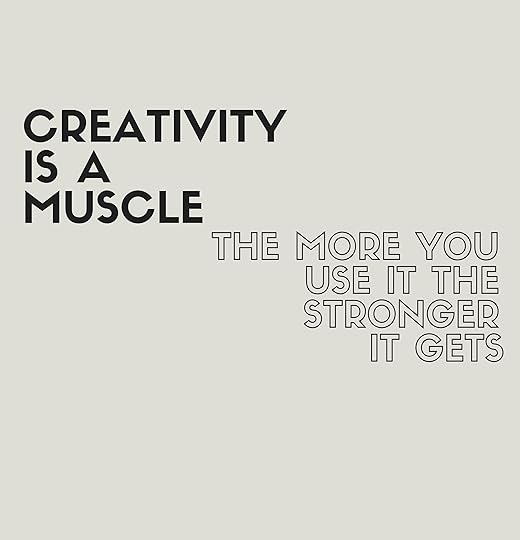
You might find that, once you start writing, you simply have too many thoughts to fit into one blog post. Don’t let that put you off – a big idea might start out as a single post, or even a series of posts, but it could end up being so much more. Plenty of bestselling books started out as blogs – just think of Julie Powell’s Julie and Julia, Pamela Slim’s Escape from Cubicle Nation and Brandon Stanton’s Humans of New York. The important thing is to start: only by writing will you be able to work out exactly how much potential your idea has.
What can they do for you
Using your best ideas isn’t just about ticking items off a list – it’s about nurturing more brilliant ideas. But how can you make this happen? First, use your audience. The people who read your blog are a valuable resource, and they can help you grow and develop your ideas in amazing and unexpected ways. Write that post, put it in front of an audience and you’ll find out what your readers respond to; they might even offer suggestions for new directions to explore. Second, exercise your creativity. Far from ‘using up’ your best ideas, taking an idea from conception to completion will inspire even more. Plus, each time you do it you’ll get more and more experienced at turning your ideas into great blog content.
So what are you waiting for? It’s time to dig out that ideas list and get writing. You never know where it might lead.
Author bio:
 Clare Diston is a Bristol-based freelance writer, editor and proofreader. Through her business, Human Voices Editorial Services, she writes blog content for businesses, and edits and proofreads fiction and non-fiction for both publishers and indie authors. She loves cross-stitch, baking and anything to do with books!
Clare Diston is a Bristol-based freelance writer, editor and proofreader. Through her business, Human Voices Editorial Services, she writes blog content for businesses, and edits and proofreads fiction and non-fiction for both publishers and indie authors. She loves cross-stitch, baking and anything to do with books!
A massive THANK YOU to Clare for contributing!
I’m always happy to consider guest posts. If you have something to share PITCH HERE
Save
Save
Save
The post Why You Should Use Your Best Blog Ideas – Now (A Guest Blog) appeared first on Amy Morse - Authorpreneur.
March 28, 2017
The Challenges Of Hiring At A Start-Up
(This is contributed content, intended to be useful and informative – I’m not a Human Resources professional – but I can refer you to one from my network.)
When your start-up is ready to grow, identifying and onboarding the right talent is one of the most challenging tasks you’ll have to tackle.
Grow Your Start-upHiring great talent will not only turn your start-up into a great place to work, but will also boost you towards your overarching goals. On the other hand, hiring poor talent will burn a hole in your capital reserves, and hurt the company culture. Here are some of the biggest challenges you’ll face when hiring for your start-up, and some tips on how to overcome them.
Finding Self-Motivated ProfessionalsThere’s a distinct lack of what recruiters call “start-up people” in the modern job market. One of the first challenges you’ll face is finding people who have the motivation to work in a small, fledgeling business. Aside from the skills they’ll need to hit the ground running in their role, it’s essential to gauge the candidate’s capacity for self-motivation, where this motivation is coming from, and what their associated expectations are, both in the short and the long term. If you hire people with a lack of motivation and self-discipline, the whole business’s productivity will suffer. There’s a more in-depth article on this on Forbes you may find useful.
Calculating CompensationImage source: Pexels
When your available capital is so stretched, it can be hard to offer up competitive salaries for all the positions you need filling. When it comes to setting compensation, you need to achieve a delicate balancing act, giving prospective candidates enough motivation to apply for your jobs without crippling your business financially. You may need to strain your resources a lot to find the kind of talent you need, or even hire in some outside help to get a good ballpark figure. Job evaluation schemes, such as that offered by Croner, provide a basis for a grading and pay structure, as well as a means to check and demonstrate you are providing equal pay for equal work. Sometimes, you may be able to attract great talent while still offering a small salary, by putting some attractive benefits on the table. Career development opportunities and a promise for a reference in the future can be exceedingly cost-effective ways to attract the crème-de-la-crème.
Assessing Soft SkillsTypically, you’ll have a round of interviews, meet with some of the other higher-ups at your business, and judge the candidates you have based on their existing skillset, and their previous experience in the work they’ll be doing. However, it’s important not to brush over what’s known as “soft skills”. The candidate’s communication skills, their level of maturity, their attitude to the tasks you’ll be giving them, and other less measurable skills will all be essential, whether they work in your marketing department or your R&D. Assessing these can be extremely hard, especially if you have no experience managing recruitment drives. However, it’s a very important job to make time for. You may hire someone to a certain position due to their impressive qualifications and experience, but later find out that their attitude simply doesn’t mesh with the company culture, and have to let them go.
When you’re at the stage of recruiting your first team members, always seek professional advice and don’t be tempted to take shortcuts or avoid your statutory responsibilities (i.e. by making everyone in your team ‘self-employed’). I have some great Human Resources professionals in my network, just ask!
*This is contributed content*
Save
For instant updates when I publish a new blog post, Follow me on Bloglovin’ For extra goodies and exclusive new information, join my mailing list HERE. I only send a newsletter monthly so I won’t spam you, I promise!If you enjoy my blogs, buy me a coffee to say thanks. Donate to my ‘Coffee Kitty’ here (£2.50 / $3 will get me a cappuccino). Thank you 
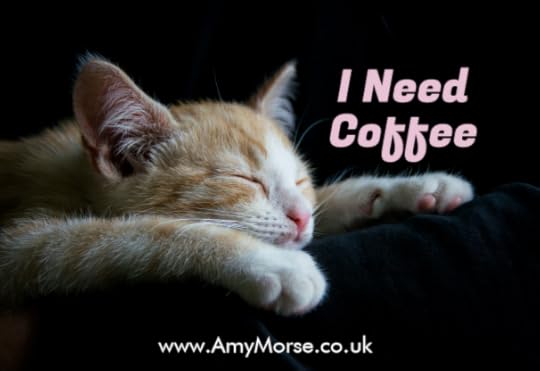
Save
Save
Save
Save
The post The Challenges Of Hiring At A Start-Up appeared first on Amy Morse - Authorpreneur.
There’s As Much Science As There Is Art In Branding
If you’re a writer or a creator of any sort, then you might already have the creative side of branding nailed down. You might know exactly what vibes you want to give off. The one thing about being a creative, however, is that it’s very self-determined. We’re used to creating what we want to see. When it comes to a brand, however, a good deal of science goes into making sure it’s what the visitor or customer wants to see as well.
Branding is part Art part Science The science of positioningA good brand, whether it’s for a personal site or for a business, has to be memorable. It has to stand out. Without keeping that mind, the steps below might have you creating a brand that ends up almost entirely the same as competitors in your industry. What https://informi.co.uk/ recommends is researching your competition first. You can use the most appealing factors of their brand as a kick-start for your own, but more than anything, they should serve as a base to distance and differentiate yourself from.
The science of finding your crowdYou don’t want to differentiate yourself so much that your brand has no relevance to your target market, however. Teams like https://www.candidsky.com/ use scientific methods like search engine optimisation to ensure that their branding efforts appear to exactly the right kind of people. For instance, thinking about keywords that people would use if they wanted to find your site and ensuring that your site is the one that appears when those keywords are used in a search query.
The science of grabbing someone’s attentionOpening the bridges for organic connections like that mentioned above pays off in the long-term. If you want to fulfil more short-term goals, like increasing the number of visitors or subscribers, then you need to wow people in the short-term. Content on your site should have value that keeps them coming back, but content alone doesn’t get more people coming. You need to think about things like the titles of your content and calls-to-action and ensure that they’re as attention grabbing as they can be without getting too obnoxious.
The science of socialisingEverything we do on the internet is getting a lot more social. If we get informed, there’s likely a comments section or buttons for sharing them. The games we play are getting more social, too. So, whatever your brand is, get social with it. Get on Facebook and Twitter. Take time to respond to comments and build a connection with your crowd.
The science of the artOf course, the artistic sides of the branding have some science to them. Sites like http://www.colour-affects.co.uk can give you some helpful information on the kind of mental connections we have with the colours you might use in your visual branding, for instance. Typography and logos have as much significance behind them. For instance, Comic Sans has become something of a joke as a font over the past decade. Not knowing that and using it will make your brand a joke, too. Know the significance of the art of your brand.
When good creativity is backed up by good science, a brand that has some impact is born. Make sure the data supports what you want to do with yours.
*This is contributed content*
For instant updates when I publish a new blog post, Follow me on Bloglovin’ For extra goodies and exclusive new information, join my mailing list HERE. I only send a newsletter monthly so I won’t spam you, I promise!If you enjoy my blogs, buy me a coffee to say thanks. Donate to my ‘Coffee Kitty’ here (£2.50 / $3 will get me a cappuccino). Thank you 

Save
Save
The post There’s As Much Science As There Is Art In Branding appeared first on Amy Morse - Authorpreneur.
March 21, 2017
How Facebook Can Drive Traffic To Your Blog
Social media was once a quiet backwater where teenagers exchanged messages about how much they loved each other. But today, it’s much more than that. It’s a global industry worth billions of dollars that has made a few people, like Jack Dorsey and Mark Zuckerberg (founder of Facebook) very rich indeed.
According to some estimates, Facebook and other social media platforms are responsible for around 30 percent of all organic traffic bloggers receive. What’s more, those estimates are now a little dated, meaning the figure today is likely to be a lot higher. This has meant that many bloggers are looking for ways to leverage social media technology, especially Facebook, to improve their engagement statistics. There are millions of blogs out there, and so the chances of a person landing on yours from a random Google search is pretty small. But thanks to the fact that Facebook allows you to create communities of followers, channelling people through to your blog from the platform is much more efficient.
The question on everybody’s lips is, how do you best use Facebook to drive traffic to your blog? Here are some ideas.
Include A Blog Tab on your Facebook pageBlog tabs are a tool on Facebook that helps drive traffic to your site. Essentially, a blog tab is a little button that guests to your Facebook page can click to get straight through to your blog site. Tabs are usually a lot more effective than hyperlinks, as they stand out more and are more attractive.
Implementing a blog tab is pretty straight forward. Websites like NetworkedBlogs have step-by-step instructions on what to do, including how to register your blog with Facebook and how to install the blog tab on your page. Once you’ve installed the tab, any blogs that you write will be immediately transmitted to your tab page, allowing your followers immediate access over the Facebook platform. In a sense, it’s a little bit like Bloglovin’ – an external aggregator site that collects blogs from all over the internet.
(For instant updates when I publish a new blog post, Follow me on Bloglovin’) Share Other People’s ContentThere’s an old saying “if you scratch my back, I’ll scratch yours.” The idea of reciprocity has been used all over the place through the centuries. Now, in it’s latest incarnation, it’s being applied to the world of online social media marketing.
If you want to drive traffic from Facebook to your blog, it’s a good idea to help other people do the same for their blogs or products. Find bloggers on Facebook who post about things that influence your target audience. For instance, if you’re a “mommy blogger” and you post about parenting, repost the content of other mommy bloggers who post about relationships. There’s a chance that the people who read their blogs will be interested in yours, and vice versa. Hopefully, by sharing their content online, they will reciprocate and share yours, growing both your audiences at the same time.
If you run a business, doing this makes it appear as if your business is more willing to share. Customers, in general, appreciate this sort of thing and are much more likely to recommend you to a friend.
Generally speaking there is an 80/20 rule accross social media (80% sharing and being helpful, 20% self promotion)
Embed Video Blogs(Such as this video – content in Spanish, but it’s just an example!)
Facebook: 1500 seguidores from Mochileros TV on Vimeo.
The power of video on social media is expanding all the time. On Facebook, video is the prime driver of engagement on the platform – far more than either text or images. For that reason, it’s a good idea to start using more video to showcase your blog. The video doesn’t have to be an actual film. It could just be a showcase of the pictures and topics covered by your blog. Think of it as a form of advertising where you’re just showing off snippets of your blog to get people interested. Once you’ve whet their appetite, they’ll be more likely to click on the video and follow through to your blog to see what all the fuss is about.
Host ContestsAnother way to generate more traffic for your blog is to take a leaf out of the business marketing playbook and host a competition. Try to relate the competition to your blog in some way. If you run a photography blog, you could have a competition to win the latest DSLR camera. Alternatively, you could offer to send two lucky people on the trip of a lifetime to somewhere really picturesque, like Borneo or Canada, where they can indulge their hobby.
It’s worth noting that while Facebook security is usually pretty good, things like competitions can open you up for an attack. Cyber criminals might try to send you links with malware attached, posing as an excited customer and so it’s worth training all your staff not to click on random links.
Share “How-To” BlogsSome bloggers think that writing “how-to” articles is a bad idea, usually because they’re seen as pretty bland. But when it comes to search engine optimization, “how to” blogs are important. When people want to know how to do something, they usually write the words “how to” and then their query.
Facebook is a good place to post how-to blogs. You don’t just want to post about your products. You also want to offer customers ideas for how they could improve their lives. Whole Foods Market, the fresh food retailer, doesn’t just announce when it’s got new stock or when it’s planning on building a new store. It also shows its customers how they can actually combine the whole foods it sells into a proper meal on its Facebook page. For instance, many people want to know how to make a sweet dessert that’s also healthy, and so Whole Foods posts recipes for stuffed dates on its feed.
Use Short Quotes From Your BlogTech companies are very good at “the teaser.” It’s another marketing ploy where a tech company announces that a product is going to be released by providing a tantalizing, but cursory, preview. A good example was when Tesla Motors teased the upcoming Model 3. Tesla only showed the outline of the car on a darkened background to whip up hype and get people’s imaginations buzzing. With so much information blanked out, rumours started, and people gave the product characteristics right out of the imagination. All the marketers had to do was sit back and see where people’s imaginations took them.
You can use a similar tactic to funnel people from Facebook to your blog by including teasers in your posts. Copy and paste an intriguing short quote from your article to get people interested. Quotes on Facebook are among the most shared things out there, so it’s worth coming up with something good.
Ask QuestionsQuestions are great. They immediately get people thinking about how they would respond. And they encourage people to find the answer – which, of course, can only be found if they click through and read about it in your blog.
When asking a question on Facebook, keep your audience in mind. Make sure that the questions always relates back to the content of the blog. You don’t want to forward people to articles on your blog which aren’t relevant or don’t actually answer the question you posed. Click-bait can be good in some situations, but not if you’re a blogger who wants to build long-term relationships with a community of people.
When Facebook was deliberating what to do with the “like button,” a company called The Next Web, used questions to great effect. They simply to put out the question “what will happen to the like button?” Before they knew it, they were inundated with people wanting to find out more.
Keep Facebook Updates Short And SweetYour blog articles might be long – 2000-words plus. But that doesn’t mean that your Facebook posts have to be long too. In fact, the precise opposite is usually a lot more effective. It turns out that when people are on Facebook, they prefer posts that are short and to the point. This means that it’s a good idea, when advertising blog articles, to keep your description to a single sentence and less than 140 characters.
It’s also worth bearing in mind that many people on your Facebook page will be accessing it using a mobile device. Keep this in mind when writing text. It should always be short and to the point.
Use Big ImagesPeople love images. According to official statistics from Facebook, posts that include images have around 120 percent more engagement than those that don’t. Savvy marketers know this, and so they spend a lot of time thinking about what constitutes the perfect image and what would best help sell the blog.
The first thing to do is to recognise that size matters. Bigger images are more engaging than smaller images. If possible, concentrate on producing images that have people in them, as these are the most clickable.
To create a full-size image on Facebook, make sure that you upload the photo directly using the photo/video upload option. Once you’ve done that, all that’s left to do is include a link to your blog in the text below the image and wait for the traffic to start flowing.
Happy Facebooking!
*This is contributed content*
Need a little more inspiration?If you’re blocked with blogging, get my ‘Blogging for Business’ book now on Amazon.
It’s a no-nonsense, step by step guide to blogging to boost your business. From what blogging is and why you should be doing it, to getting tonnes of traffic and making money from it.
Or if you like the personal touch, talk to be about one to one content coaching sessions HERE
Save
Save
Save
The post How Facebook Can Drive Traffic To Your Blog appeared first on Amy Morse - Authorpreneur.



